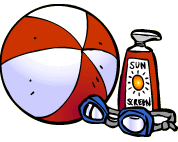SWIMMING ACTIVITY CARD
Parts of the Body Worked

Upper & Lower Legs

Heart & Lungs

Arms

Shoulder & Neck

Back

Check out swimming for your next activity.
Gear Up
Pick out a swimsuit that fits your style. If you plan to swim competitively, you’ll need a suit that is lightweight and stretchy. It should also fit snugly so it won’t slow you down when you’re racing or slip off as you dive into the water!
A pair of goggles will allow you to see where you are going underwater without your eyes feeling itchy and irritated. They even make prescription goggles so you can see underwater if you wear glasses!
Finally, if you’re outside, you’ll wanna guard against the sun. So, rub on some sunscreen!
Games
Wet T-Shirt Relay. Got two T-shirts, some friends, and time at the pool? Then you’re ready to play! Divide into two teams and have half of each team line up on opposite sides of the pool. When you’re ready to go, the first player on each team puts on the wet T-shirt and jumps into the pool. (No running to jump in!) The players swim across to the other side as fast as they can and tag the next person in their team’s line. Then they take off the wet T-shirt and give it to their teammate to put on. As soon as it’s on, the next swimmer can jump in and go. The first team to have all of its swimmers finish the relay wins!
Play it Safe
Learn to swim and always swim with a friend. It’s more fun and having a friend there if you need one is just plain smart!
Make sure to respect rules and lifeguards. Pool rules like “no running” or beach rules like “no swimming outside the flags” are there to protect you. (And lifeguards enforce them so that you can stay safe, not to ruin your fun.) Make sure a lifeguard or an adult can see you just in case you need help.
Don’t try to keep up with stronger or more experienced swimmers, especially if they swim out further than you think you can swim back.
Swimming is real a workout! So, take breaks. If you get tired while you’re in the water, float on your back for a few minutes until you get your power back!
Make sure to keep an eye on mother nature. If you spot bad weather (dark clouds, lightening), it’s time to take the fun inside.
And when you get out of the water, tilt and shake your head to let all of the water drain out of your ears — “swimmers ear” can be a real pain!
Diving makes a splash, but make sure you know how deep the water is before you leap.
Check out other must-read tips on water activities!
How to Play
Swimming is more than a great way to cool off when it’s hot, it’s also a fun activity that helps you work out your whole body. If you don’t know how to swim, or you want to brush up your skills, you’ll want to take some lessons at your local pool. There, you’ll master the basics to help keep your head above water.
Floating. Our bodies have a natural tendency to float — so go with it! Relax and let the water support your body. Lie back with your arms stretched out to the side. Turn your palms up and keep the backs of your hands in the water. Arch your back, stretch out your legs (some gentle kicking will help you float easier), and take short breaths to stay relaxed. Floating is a great way to rest, or rest while you call for help if you don’t have enough energy to swim to shore or the side of a pool.
Treading water. Another way to keep afloat is to tread water. Get into the water and pretend you are gently riding a bicycle, with your back straight and your arms straight out in front of you. Sweep your arms together with your palms facing down and in. Then, sweep them back out with your palms facing down and away from each other.
Now that you know how to keep your head above the water, try swimming with your head below water!
Swimming underwater. Breathe in as much air as you can and then let it all out, take one more breath and hold it, and slide under the water. (Even though it seems like taking lots of quick breaths before going underwater could help you, doing that is called “hyperventilating” and it can actually make you pass out underwater. Not good!) Stretch out your body with your legs together and your arms straight out a little bit above your head. Pull your legs up then kick them apart to start gliding. Next, bring your legs together and kick in a scissor motion to move around. While you kick, put your arms out to your sides and push them back towards your legs. Glide as far as you can, and then come back up when you need a breath. Try to stay relaxed and don’t push yourself too far. The more you practice, the stronger your lungs will become.
Once you’ve got the basics, to be a strong swimmer and enjoy lots of water activities, you’ll need to learn these strokes: backstroke, breaststroke, freestyle, and butterfly — to name a few!
Ology
The Law of Gravity explains that what goes up must come down. When you’re in the water, the higher you try to lift your head, the more gravity will try to push you down. So, if you want to float, try to keep yourself underwater and you will naturally float at the surface. But if you lift your head, arms, or legs out of the water, you’ll sink right back down.
Fun Facts
Elephants can swim up to 20 miles a day! They stick their trunks above the water like snorkels.
At the 2000 Summer Olympics in Sydney, Australia, the USA won 33 swimming medals, including 14 gold medals.
It takes about 800,000 gallons of water to fill up an Olympic-size pool.
Related Links
- Page last reviewed: May 9, 2015
- Page last updated: May 9, 2015
- Content source:



 ShareCompartir
ShareCompartir